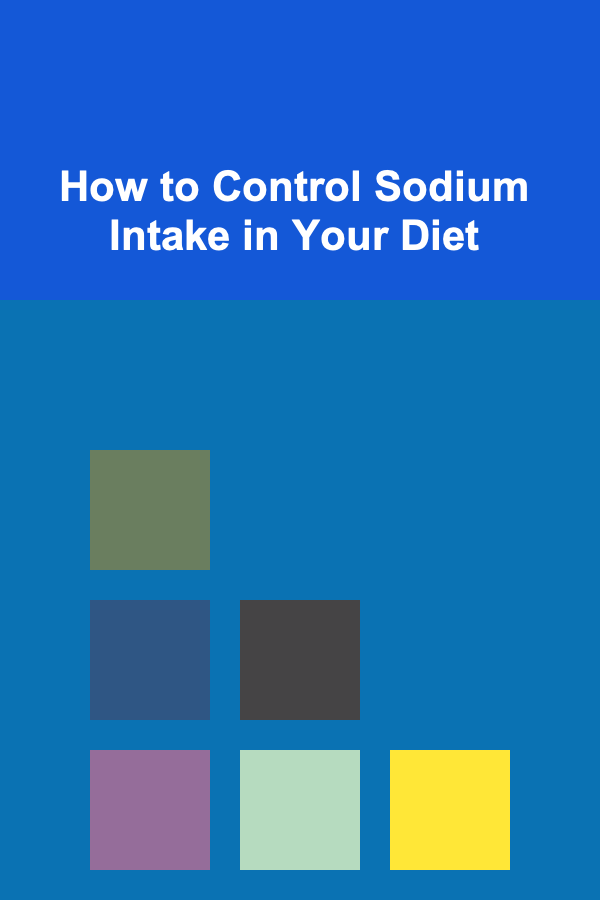
How to Control Sodium Intake in Your Diet
ebook include PDF & Audio bundle (Micro Guide)
$12.99$5.99
Limited Time Offer! Order within the next:

Sodium is an essential mineral that plays a crucial role in maintaining fluid balance, nerve function, and muscle contractions in the body. However, excessive sodium intake can have negative health effects, contributing to high blood pressure (hypertension), heart disease, stroke, kidney disease, and other serious health conditions. According to the Centers for Disease Control and Prevention (CDC), the average American consumes about 3,400 milligrams of sodium daily---much higher than the recommended daily limit of 2,300 milligrams for healthy adults.
Controlling sodium intake is a critical step toward maintaining optimal health. The challenge lies in understanding how much sodium is in the foods we eat and how to make healthier choices. This article will provide in-depth strategies for controlling sodium intake, improving your overall diet, and taking proactive steps to safeguard your long-term health.
Understanding Sodium and Its Effects on the Body
What is Sodium?
Sodium is a chemical element found naturally in many foods. It's most commonly consumed in the form of sodium chloride (table salt), but can also be found in other food additives, preservatives, and natural ingredients. Sodium helps regulate fluid balance in the body and is essential for nerve and muscle function.
However, consuming too much sodium can be harmful to your health. The body tries to maintain a delicate balance of sodium and water, and excessive sodium can lead to high blood pressure, which in turn increases the risk of cardiovascular diseases, kidney disease, and other complications.
The Link Between Sodium and High Blood Pressure
One of the most well-established health risks associated with high sodium intake is hypertension (high blood pressure). When you consume too much sodium, it causes your body to retain water, which increases the volume of blood in your bloodstream. This puts more pressure on your blood vessel walls, leading to high blood pressure.
Chronic hypertension is a major risk factor for heart disease, stroke, kidney disease, and other life-threatening conditions. According to the World Health Organization (WHO), reducing sodium intake can help lower blood pressure and reduce the risk of these diseases.
Recommended Sodium Intake Levels
Daily Sodium Recommendations
The recommended daily limit for sodium intake varies based on age, health status, and individual needs. For most adults, the American Heart Association (AHA) recommends consuming no more than 2,300 milligrams (mg) of sodium per day, which is roughly equivalent to one teaspoon of salt. However, the AHA further suggests aiming for an ideal target of no more than 1,500 mg per day for optimal heart health, especially for individuals with high blood pressure, heart disease, or risk factors for these conditions.
For children, the recommended daily sodium intake is lower, depending on their age:
- Ages 1--3: 1,500 mg/day
- Ages 4--8: 1,900 mg/day
- Ages 9--13: 2,200 mg/day
- Ages 14--18: 2,300 mg/day
The Sodium Content in Common Foods
While sodium is naturally found in some foods (such as vegetables, dairy products, and meats), the majority of sodium in modern diets comes from processed and packaged foods. The following are common foods that can contain high levels of sodium:
- Processed meats: Bacon, ham, sausage, hot dogs, deli meats
- Canned foods: Soups, vegetables, beans, and sauces
- Packaged snacks: Chips, crackers, pretzels, and popcorn
- Condiments and sauces: Soy sauce, ketchup, mustard, salad dressings
- Frozen foods: Pizza, frozen dinners, and other ready-to-eat meals
- Restaurant foods: Fast food, takeout, and sit-down restaurant meals
- Cheese: Many types of cheese, such as processed and cheddar, contain high sodium levels
It's important to be aware of hidden sodium in foods that may not taste salty, as this can quickly add up throughout the day.
How to Control Sodium Intake
1. Read Food Labels
The first step in controlling your sodium intake is being aware of how much sodium is in the foods you eat. Food labels are a helpful resource for this, as they list the sodium content per serving. Look for products that contain less than 140 mg of sodium per serving, which is considered a "low-sodium" food. Also, be mindful of the serving size---some packaged foods may contain multiple servings, and it's easy to consume more sodium than intended.
Tips for Reading Food Labels:
- Choose foods labeled as "low-sodium," "sodium-free," or "no salt added."
- Compare similar products and choose the one with the lowest sodium content.
- Be cautious of "lite" or "reduced sodium" labels, as they may still contain a significant amount of sodium.
2. Cook More at Home
Preparing meals at home allows you to control the amount of sodium that goes into your food. Restaurant meals and processed foods often contain large amounts of hidden sodium, so cooking from scratch can help you reduce your intake significantly.
When cooking at home, you can use herbs, spices, and other flavoring agents to add taste without adding extra salt. Fresh herbs such as basil, rosemary, oregano, and thyme can provide bold flavors, while citrus fruits (lemons, limes) and vinegar can also enhance taste without sodium.
3. Use Less Salt
A simple yet effective way to control sodium intake is by using less salt in your cooking and at the table. Start by gradually reducing the amount of salt you add to meals. Over time, your taste buds will adjust to lower levels of sodium, and you may find that you don't miss the extra salt.
If you prefer salty foods, try using salt substitutes, such as potassium chloride, which can provide a salty flavor without the harmful effects of sodium. However, be cautious with salt substitutes if you have kidney problems or other medical conditions, as they may contain high levels of potassium.
4. Opt for Fresh or Frozen Produce
Fresh and frozen fruits and vegetables are naturally low in sodium. Canned vegetables, on the other hand, often have added salt as a preservative. If you must use canned vegetables, look for options labeled "no salt added" or "low sodium."
Additionally, frozen vegetables can be just as nutritious as fresh ones, and they usually have less sodium compared to canned versions. When buying frozen meals or vegetables, always check the label for sodium content.
5. Avoid Processed and Packaged Foods
One of the easiest ways to reduce sodium intake is to limit the consumption of processed and packaged foods, which are notorious for their high sodium content. Many pre-packaged meals, snacks, and convenience foods contain large amounts of salt to preserve the food and enhance its flavor.
Instead, focus on whole, unprocessed foods such as fruits, vegetables, lean proteins (chicken, fish, tofu), whole grains, and legumes. If you're craving a snack, opt for unsalted nuts, popcorn, or fresh fruit.
6. Reduce Restaurant and Takeout Meals
Restaurant and takeout meals often contain much higher levels of sodium than homemade dishes. When dining out, try to choose restaurants that offer healthy options or those that provide nutrition information. Don't hesitate to ask the chef to prepare your meal with less salt or to serve sauces and dressings on the side.
Fast food is particularly high in sodium, so it's best to avoid it or choose healthier alternatives when available. Many fast food chains now offer lower-sodium options, so it's worth exploring these choices.
7. Experiment with Salt-Free Seasonings
There are many salt-free seasoning blends and mixes available that can add flavor to your dishes without the added sodium. These often contain dried herbs, garlic, onion powder, pepper, and other spices. You can also create your own seasoning blends using fresh or dried herbs.
Sodium Reduction for Specific Populations
For People with High Blood Pressure
If you have hypertension or are at risk of developing it, sodium reduction is especially important. Limiting sodium can help lower blood pressure and reduce the risk of cardiovascular events. The DASH (Dietary Approaches to Stop Hypertension) diet is specifically designed to lower blood pressure by emphasizing foods that are low in sodium, rich in potassium, magnesium, and fiber, and high in fruits, vegetables, whole grains, and lean proteins.
For People with Kidney Disease
People with kidney disease are also advised to control their sodium intake. The kidneys play a crucial role in regulating sodium levels, and excessive sodium can strain the kidneys. If you have kidney disease, work with a healthcare provider or nutritionist to develop a dietary plan that meets your specific needs.
Conclusion
Reducing sodium intake is a vital step toward improving your health and lowering the risk of chronic diseases such as high blood pressure, heart disease, and kidney disease. By being mindful of food labels, cooking at home, using less salt, and focusing on fresh, whole foods, you can significantly cut your sodium intake and enjoy a healthier, more balanced diet.
With the right knowledge and strategies, controlling sodium intake doesn't have to be difficult. Start small, make gradual changes, and over time, you'll reap the benefits of a lower-sodium lifestyle that supports better health for years to come.

How to Choose the Right Rugs for an Organized Living Room
Read More
How to Create a Harmony Between Function and Aesthetics
Read More
How to Set Up an Indoor Scavenger Hunt for Kids
Read More
How to Stage Your Home for a Quick Sale on a Budget
Read More
How To Discuss a Movie's Costume Design
Read More
10 Tips for Maximizing Your Retirement Contributions
Read MoreOther Products

How to Choose the Right Rugs for an Organized Living Room
Read More
How to Create a Harmony Between Function and Aesthetics
Read More
How to Set Up an Indoor Scavenger Hunt for Kids
Read More
How to Stage Your Home for a Quick Sale on a Budget
Read More
How To Discuss a Movie's Costume Design
Read More